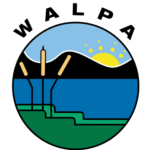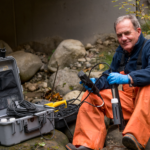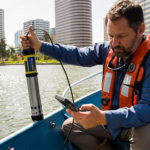Fish-focused annual conference hooks membership
by Matthew Colston, WALPA President
On October 4th through 6th, WALPA members from across the state came together at the UW Tacoma Campus for the 36th annual conference, Fish and Beyond in Our Lakes. More than 80 attendees showed up for great presentations about fish and lake health.
Rapid response deployed to keep quagga mussels out of the Columbia River system
WATERLINE SPONSORED CONTENT
by Terry McNabb, Aquatic biologist/Lake manager, Aquatechnex
Zebra and quagga mussels are a major threat to the waters of the Pacific Northwest. These invasive species were first discovered in the Great Lakes in the 1980’s and are assumed to have been introduced from Europe via ballast water carried by ocean-going cargo ships. These species reproduce rapidly; one mussel can generate up to 14,000 larva or veligers per year.
Finding hope for the future of Lake Sammamish Kokanee by quantifying food web interactions
by Nicole Doran, Dave Lamb Memorial scholarship winner, and third year Master’s student at the University of Washington School of Aquatic and Fishery Sciences.
Not all salmon go to the ocean. Kokanee salmon (Oncorhynchus nerka) are a freshwater ecotype of sockeye salmon that have evolved to spend their entire lives in lakes. One such lake is Lake Sammamish, located in western Washington just twenty miles east of Seattle. Kokanee, also known locally as the “little red fish”, is an incredibly important species for the local communities of Sammamish. They were a traditional food and culturally important animal to the Snoqualmie Tribe. Lake Sammamish Kokanee are also genetically distinct from other Kokanee populations in the Pacific Northwest and British Columbia. You can read more about the Snoqualmie Tribe’s connection to Lake Sammamish and Kokanee here! They were once a popular sportfish in Lake Sammamish for recreational anglers as well. However, drastic population declines over the past few decades have affected both recreational fishers and the Snoqualmie Tribe’s relationship to the little red fish.
Assessing the effects of recreational boating on the water quality of Idaho’s Payette Lake
Advancements in technology simplify water quality monitoring
WATERLINE SPONSORED CONTENT
by In-Situ staff
Continuous water quality monitoring is our most effective tool to better understand how the changing climate impacts ecosystems, wildlife, industry, and human health.
However, the challenges of continuous data collection have made it impractical for many researchers. Biofouling and routine maintenance such as battery replacement and calibration typically demand frequent trips to the field to clean and care for equipment.
Celebrating a champion for Washington lakes: this year’s Secchi Disk Award recognizes Rob Zisette for his outstanding leadership and passion for lake protection
 By Katie Sweeney with contributions from Carol Slaughterbeck (Herrera), Joy Michaud (Herrera), Jen Oden (Snohomish County), and Josh Wozniak (Parametrix)
By Katie Sweeney with contributions from Carol Slaughterbeck (Herrera), Joy Michaud (Herrera), Jen Oden (Snohomish County), and Josh Wozniak (Parametrix)
This year, joining the high ranks of Washington state lake leaders honored with the coveted Secchi Disk Award, is none other than Rob Zisette! In keeping with WALPA tradition, Rob was surprised with the award during WALPA’s 36th annual conference: Fish and Beyond in Our Lakes, where he was presented with his very own Secchi disk adorned with well wishes from the 2023 Board of Directors and WALPA membership. Backlit by a floor-to-ceiling slideshow of photos capturing some of Rob’s greatest lake moments and colleagues’ fondest memories of working with Rob, WALPA President Matthew Colston related some of Rob’s achievements, followed by testimonials from colleagues and fellow WALPA members Marisa Burgdoff and Katie Sweeney.













